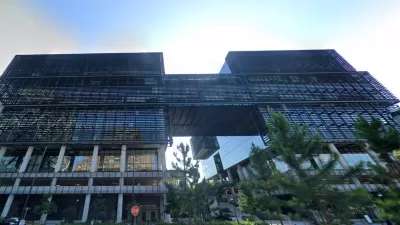Jeffrey Spivak reports on the federal government's pioneering efforts in net-zero building design and construction.
For those not familiar, "a net-zero building is one that, over the course of a year, produces as much energy as it needs through a combination of technological efficiencies and its own on-site energy generation, such as solar power," notes Spivak.
Although the amount of commercial buildings constructed to this high standard over the past decade can be counted with a few hands, "the federal government has taken net-zero architecture to a new level by incorporating it in larger commercial buildings," writes Spivak.
Such buildings as NASA's Sustainability Base at the Ames Research Center complex near San Jose, California, and the Department of Energy's 220,000-square-foot Research Support Facility at the National Renewable Energy Laboratory campus in Colorado, are introducing pioneering design and technologies not yet found in the private sector.
As it did in leading the way in the adoption of LEED standards at the beginning of the last decade, "it's the federal government that's been the most aggressive in mandating net zero energy for its next generation of buildings," beginning in 2007, reports Spivak.
And the government has set targets for net-zero adoption across all commercial buildings as well. "[T]he Department of Energy's Net-Zero Energy Commercial Building Initiative aims to research and market emerging technologies for net-zero buildings, with a goal of converting half of all public and private commercial buildings to net-zero energy by 2040 and the entire stock of U.S. commercial buildings by 2050."
FULL STORY: Uncle Sam, the Energy Miser

Alabama: Trump Terminates Settlements for Black Communities Harmed By Raw Sewage
Trump deemed the landmark civil rights agreement “illegal DEI and environmental justice policy.”

Study: Maui’s Plan to Convert Vacation Rentals to Long-Term Housing Could Cause Nearly $1 Billion Economic Loss
The plan would reduce visitor accommodation by 25% resulting in 1,900 jobs lost.

Why Should We Subsidize Public Transportation?
Many public transit agencies face financial stress due to rising costs, declining fare revenue, and declining subsidies. Transit advocates must provide a strong business case for increasing public transit funding.

Paris Bike Boom Leads to Steep Drop in Air Pollution
The French city’s air quality has improved dramatically in the past 20 years, coinciding with a growth in cycling.

Why Housing Costs More to Build in California Than in Texas
Hard costs like labor and materials combined with ‘soft’ costs such as permitting make building in the San Francisco Bay Area almost three times as costly as in Texas cities.

San Diego County Sees a Rise in Urban Coyotes
San Diego County experiences a rise in urban coyotes, as sightings become prevalent throughout its urban neighbourhoods and surrounding areas.
Urban Design for Planners 1: Software Tools
This six-course series explores essential urban design concepts using open source software and equips planners with the tools they need to participate fully in the urban design process.
Planning for Universal Design
Learn the tools for implementing Universal Design in planning regulations.
Smith Gee Studio
Alamo Area Metropolitan Planning Organization
City of Santa Clarita
Institute for Housing and Urban Development Studies (IHS)
City of Grandview
Harvard GSD Executive Education
Toledo-Lucas County Plan Commissions
Salt Lake City
NYU Wagner Graduate School of Public Service





























